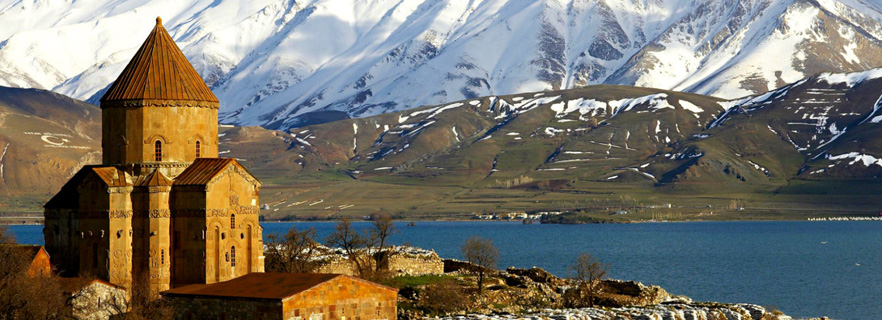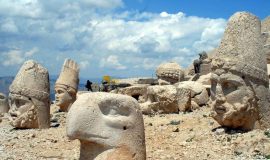 Van
Van
Since it is an important geographical location, it has been a residential area since ancient times and has been covered with many civilizations' traces. Having been the capital city of Urartu Civilization, Van has carried many cultures like Hurriler, Hittites, Persians, Medlar, Seljuks and Ottomans until today.
Van Lake, Akdamar Church, the landmarks that make it known as "the city of the cities", the world famous cat and the geography that allows many tourism activities, is an important tourism center of the East.
Districts:
The provinces of Van; Bahçesaray, Bashkale, Çaldıran, Çatak, Edremit, Ercis, Gevas, Gurpinar, Muradiye, Özalp and Saray'dır.
Gevaş: It is 40 km to Gevaş Van. Distance. Among historical and touristic objects found in Gevaş are the Izzettin Sir Mosque and Kulliyesi, the Halime Hatun (Celme Hatun) mosque in the Middle Quarter, the Seljuk Turks Cemetery, the Akdamar Island with its historical value and the Church.
Gürpınar: It lies to the south of Van province. The historical and touristic places in the province are Çavuştepe Castle and Haşap Kalesi.
Çatak: Taşköprü, Hulkan bridge and Ziril Köprüleri on the Çatak Brook are historical remnants made in the 15th century. Apart from these, the most important historical monuments are the hunting and animal figures drawn on rocks and movable stones of Tirşin Yaylas. There is also the Virgin Mary Church in the Triple Mezras of Bilgi Village, which consists of 365 rooms. There is a natural hot spring in the direction of Atlýhan Village. 5 km from the valley of Çatak. The distance White water (Ganisipi) Waterfall is an interesting nature work.
Edremit: 18 km from Van. Distance. Edremit stretches along the South-South eastern shoreline of the Van Gölünün and stands in front of the blue lake as a green cover. Historical Dukaya Höyüğü, Hatti Nails from Urartular Period, Kız Damı (Giant Dam) Walls and Savacak Waterfall in Kadenbastı area, Treasure Piri (Treasure Gate) and Harbedar (Harebe Village) in Elmalık district are worth seeing.
Van Lake and Akdamar Island
Van Lake, which gives its name to Van province, is the biggest soda lake in Turkey and the world. It is surrounded by high mountains on all four sides. There are 4 islands in Akdamar, Adır, Çarpanak, and Kuş islands. It is also called Deryaçe (Small Sea) as it is called High Sea, Nairi Sea and Upper Sea. The water of the lake is too salty and carbonated. It gives foam without soap and everything can be washed and cleaned without using cleaning agents. The lake, which has a different color every season, every hour, sunrise and sunset, is an important contribution to the tourism of the region. Coastal along the coast of the unspoiled coast, green vegetation is wrapped around the coast is worth seeing.
Ahtamar Island, the largest of the islands in Van Lake, is famous for its church. The church built by King Gagik at the beginning of the 900's is one of the most outstanding examples of stone workmanship. The dolmus engines from Gevaş pier are working on the Akdamar Island.
Castles
In a sense, Van can be called "Kaleler Kenti". There are a large number of small castles in and around Van. Some of these historic monuments are from the Urartian period, others from the Middle Ages and later.
Important Kaleler Down and Up Zivastan Castle, Beyüzümü Castle, Çatak Castle, Lamurkesen (Zernek) Castle, Hishit Castle, Pizan (Örenkale) Castle, Kalecik, Zernaki Tepe Castle, Muradiye Castle, Albak (Baskale) Castle, Deliçay Castle, Çelebibağ Castle, Yoncatepe Castle, Müküs Castle and Amik Castle.
Van Castle: Van Castle is located within the borders of Van city center, 5 km. . They are the glory of Urartian calendars.
B.C. It was built by Lutupri's son, I. Sarduri, in the 9th century. The oldest known Urartian inscription, written in Assyrian nail writings, belonging to I Sarduri, is located on the northwestern end of the castle, which is largely occupied by stone blocks called Sardur burcu. Another important structure of the Kalen is the Horhor Inscriptions, the longest inscription of the Urartu, which is found on the rock tomb of I. Agrişti and immediately outside the rock. In addition, in the northern slope of the castle II. There are open-air temples of Sarduri (Analı-Kız), grave rooms of Menau and Sarduri in the castle, caves, water cisterns and various rooms.
There are ruins of old town on the south side of castle. Ulu Mosque, Hüsrev Paşa Mosque, Kay Çelebi Mosque, Hamamlar (Double Bath) Kumbets (Twin Kümbet) and most of the ruined old houses, travels among the leaves of history tourists.
Hoşap Kalesi: It is 60 km to Van city center. (Güzelsu) on the Van-Hakkari highway in the district of Gürpınar. The castle, built on a steep rock mass, consists of an inner fortress and the outer fortress to its north. Surveillance towers, walls, bastions, body walls, mosque, oven, dungeon kiosk, harem, selamlık and original iron door wings are important structures of the castle. Also on the south side of the castle is the oldest Ottoman bridge in the Van region.
Ağartı Kalesi: The castle built on the eastern shore of Van Lake is well preserved and the fortification walls coming up to the day are built with andesite stone blocks.
Kef Castle: It is one of the important centers of the Urartu. There is a multi-room palace, animal and plant reliefs.
Çavuştepe Castle: 25 km from the center of Van Province. It is located in Çavuştepe village of Gürpınar district in the distance. The castle, which was founded on the western side of the Bol Mountains, Down and up. Castle, II. Sarduri by BC It was built between 764-734. There are Haldi temples, open air temples, ramparts, warehouses, stables, palace buildings, water cisterns and nail writings in the monuments.
Ayanıs Castle: It is 35 km to Van. It is in Ayanıs village in the distance. Argishi's son Rusa It was built between 645-643. It is very important in terms of illuminating the last stages of Urartu history. It is an area built near the shore of the Van Lake.
Toprakkale: It lies on a rocky hill bounded by the Zylzim Mountains in the east of Van province center. Castle is the king of Urartu II. By Rusa It was built between 685-645. There are cisterns, open-air temples, rock-cut staircases.
Lower-Upper Anzaf Monuments: 10 km from Van. It is located near the Van-Ozalp highway in the north east. Lower and Upper Calendars. There are walls, towers, workshop, warehouse, palace structure, inscription on both sides.
Churches
Akdamar Church: It is the largest church in Van Lake, within the Gevaş district limits. The church, which was founded in the south east of Adan, is 3 km. Away. At all hours of the day, Akdamar Island is accessible by motorboats on the beach.
In the name of the Holy Cross, the King of Vaspurakan was built by I. Gagik to the monk Manuel. The repertoire of the church is quite rich. Beside this, there are various scenes from the Bible and the Torah. Prophet of the Dolphin to the sea, Hz. Jesus and Jesus in his lap, Adam and Eve excluded from Paradise, Hz. The struggle between David and King Goliat is the Samson Palestinian duo, three Hebrew youths in the fire, and Daniel in the Lion's stadium. It is possible to see rich animals, vine vines and various figures.
Adir Church: The church is located on the same named island in Van Lake, near the laying hamlet of Yaylıyaka village bound to the Van center. It is located on the south side of the island. The monastery was built in 1305. Later in 1621, St. Georges Church was added. Nearby boats on the beach and boats to be rented from Van Pier can be seen and seen.
The Seven Churches were built on the skirts of Erek Mountain in the 8th century.
Mosque, Madrasa and Kumbets
The important goblets in Van are Ulu Mosque, Hüsrev Paşa Mosque, Red Mosque, Gevaş İzzetin Çir Mosque, Süleyman Han Mosque, Kaya Çelebi Mosque, Horhor Mosque and Abbasağa Mosque. Husrev Pasha Madrasah, Hosap Hasan Bey Madrasah, Hosap Evliya Bey Madrassa, Gevas Halime Hatun Kümbeti, Erciş Anonim (Zortul) Kümbet is worth seeing
Bridge and Water Canal
Van's Bridge Bend-i Mahi Bridge, Red Bridge, Çatak Bridge, Hurkan Bridge, Zeril Bridge, Devil Bridge can be considered as.
The first irrigation canals and dams in Van BC Between the 9th and 6th centuries it was built during the Urartian period. The most important of these is the Menua (Semiramis / Shamran) irrigation channel. It was built by the King Urartu Menua. Menua / Shamran has given life to the places where channeled world engineering has been a wonder, and continues to function as a day-to-day operation.


 Van
Van











